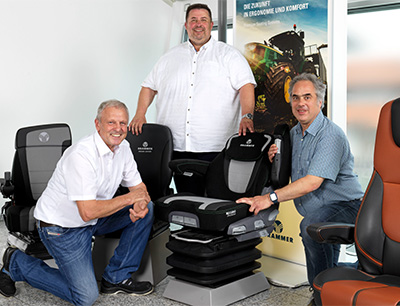
When you want honest feedback, you ask a friend. The new mixing head from Krauss-Maffei is therefore undergoing its first series application at longstanding partner Grammer, with excellent results. The “precision Mixhead 8/12-2K-40” is smaller, lighter and offers even better homogeneity when dispensing polyurethane foam. You can see them on tractors, forklifts and in large trucks. When you see the hallmark design, it is clear that the seat comes from market leader Grammer. The company processes polyurethane foams with enormous efficiency and an extremely low reject rate on the entire process. The plant creates around 600,000 seats per year. Therefore, Krauss-Maffei selected the company to test the newly developed transfer mixing head. Both companies have been working together successfully for decades.
Smaller, lighter, and with even better mixing quality: these were the objectives when the redesign project began at the end of 2020. The team headed by Ralf Moser, head of mixing head development, took on board the wishes of customers for whom convenient handling in everyday production is important. In most cases, the mixing head is attached to robots that transport them at high speed from mold to mold, where foam discharge takes place. A weight reduction from 13 to 10.4 kilograms is definitely noticeable here. The geometry has also been streamlined: the L-legs of the “precision Mixhead 8/12-2K-40” have been reduced to 65 and 92 percent of the original values.
The mixing head is the heart of the polyurethane foaming system because this is where it is decided whether the polyol and isocyanate components will be homogenized thoroughly and in the desired ratio. If this does not happen, sticky spots appear on the cured foam or it is too hard or too soft. Both raw materials flow through nozzles (throttled by needles) into the mixing chamber, where they are atomized and mixed at 100 to 200 bar. If material is to be discharged, the control piston opens the path to the mixing chamber until the shot weight is reached. For use in open molds, a transfer mixing head is required, in which the resulting foam is deflected at a 90-degree angle into the outlet chamber and completely ejected by a cleaning piston. Krauss-Maffei has held numerous patents for this technology since the 1980s and the mixing heads are known in the industry for their high performance.
Grammer, supplier of seating solutions for commercial vehicles, operates two rotary table systems at its Haselmühl plant, each with over 20 molds for tractor, construction machinery and forklift seats. A mixing head demonstrates its capabilities with the lowest possible material discharge. Grammer runs at 220 to 250 grams per second in series production. With the new mixing head, the team led by Heinrich Hammer, head of process engineering at Grammer, tested the limits. "We went down to 60 grams and homogeneity and uniformity were still top-notch. The production window has become enormously wide as a result." Another benefit of the new generation of mixing heads is that certain components have been simplified and made interchangeable, increasing the ease of maintenance. For the first time, the mixing chamber, outlet chamber and control piston can be completely replaced if worn. The latter two are now single-piece, previously multi-piece, which in turn saves space and weight. “We are highly satisfied with the results and the tests of the mixing head on our plant”, emphasizes Heinrich Hammer, Head of Process Engineering at Grammer.